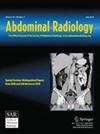球囊辅助胃造口管置入。
IF 2.2
3区 医学
Q2 RADIOLOGY, NUCLEAR MEDICINE & MEDICAL IMAGING
引用次数: 0
摘要
目的:比较气囊辅助胃造口术(BAG)与常规连续扩张术的安全性和有效性。方法:本研究是一项经irb批准的回顾性研究,涉及2012年至2021年间在一家机构的介入放射科放置的所有经皮胃造口管。共发现476例患者(平均年龄63岁,44%为女性):连续扩张组385例,气囊辅助胃造口组91例。在医疗记录中回顾患者人口统计学、手术和放射学数据,以确定手术成功、手术/透视时间和插管失败。胃造瘘管失败定义为管漏、堵塞或移位。不良事件按照介入放射学会指南进行分类。统计分析酌情采用Fisher精确检验、学生t检验和Mann-Whitney u检验。结果:采用连续扩张技术的患者胃造瘘管置入率为97.7%(377/385),采用BAG技术的患者胃造瘘管置入率为100%(91/91)。放置BAG管与平均透视时间减少2.5分钟(47%)相关(p = 0.0002, CI: 3.76至1.20)。总手术时间平均减少17.2分钟(22%)(p = 0.0006, CI: 26.9至7.4)。BAG还与全因胃造口管失败发生率降低11%相关(p = 0.0399)。两组在不良事件发生率和中位管失效天数方面无统计学差异。BAG组的材料成本高出178.32美元。结论:与连续扩张技术相比,BAG置管可以安全有效地进行,并且可以减少透视时间、手术时间和总体失败率。本文章由计算机程序翻译,如有差异,请以英文原文为准。
Balloon assisted gastrostomy tube placement.
求助全文
通过发布文献求助,成功后即可免费获取论文全文。
去求助
来源期刊

Abdominal Radiology
Medicine-Radiology, Nuclear Medicine and Imaging
CiteScore
5.20
自引率
8.30%
发文量
334
期刊介绍:
Abdominal Radiology seeks to meet the professional needs of the abdominal radiologist by publishing clinically pertinent original, review and practice related articles on the gastrointestinal and genitourinary tracts and abdominal interventional and radiologic procedures. Case reports are generally not accepted unless they are the first report of a new disease or condition, or part of a special solicited section.
Reasons to Publish Your Article in Abdominal Radiology:
· Official journal of the Society of Abdominal Radiology (SAR)
· Published in Cooperation with:
European Society of Gastrointestinal and Abdominal Radiology (ESGAR)
European Society of Urogenital Radiology (ESUR)
Asian Society of Abdominal Radiology (ASAR)
· Efficient handling and Expeditious review
· Author feedback is provided in a mentoring style
· Global readership
· Readers can earn CME credits
 求助内容:
求助内容: 应助结果提醒方式:
应助结果提醒方式:


